BMW X3 xDrive30i 2010, X3 xDrive28i 2010 Owner's Manual

Owner's Manual for Vehicle
The Ultimate
Driving Machine
Contents
A - Z
Online Edition for Part no. 01 41 2 602 348 - © 02/09 BMW AG
Online Edition for Part no. 01 41 2 602 348 - © 02/09 BMW AG

X3 xDrive28i
X3 xDrive30i
Owner's Manual for Vehicle
Congratulations, and thank you for choosing a BMW.
Thorough familiarity with your vehicle will provide you with enhanced control and security when you drive it. We therefore have this request:
Please take the time to read this Owner's Manual and familiarize yourself with the information that we have compiled for you before starting off in your new vehicle. It contains important data and instructions intended to assist you in gaining maximum use and satisfaction from your BMW's unique range of technical features. The manual also contains information on maintenance designed to enhance operating safety and contribute to maintaining the value of your BMW throughout an extended service life.
This manual is supplemented by a Service and Warranty Information Booklet for US models or a Warranty and Service Guide Booklet for Canadian models.
We wish you an enjoyable driving experience. BMW AG
Online Edition for Part no. 01 41 2 602 348 - © 02/09 BMW AG
© 2009 Bayerische Motoren Werke Aktiengesellschaft
Munich, Germany
Reprinting, including excerpts, only with the written consent of BMW AG, Munich.
US English II/09
Printed on environmentally friendly paper, bleached without chlorine, suitable for recycling.
Online Edition for Part no. 01 41 2 602 348 - © 02/09 BMW AG

Contents
The fastest way to find specific topics is to use the index, refer to page 130.
Using this Owner's Manual
4 |
Notes |
7 |
Reporting safety defects |
At a glance
10 Cockpit
Controls
18 Opening and closing
27 Adjustments
35 Transporting children safely
38 Driving
46 Everything under control
50Technology for comfort, convenience and safety
59 Lamps
63 Air conditioner
69 Practical interior accessories
Driving tips
82 Things to remember when driving
Mobility
92 |
Refueling |
94 |
Wheels and tires |
101 |
Under the hood |
106 |
Maintenance |
108 |
Care |
111 |
Replacing components |
120 |
Giving and receiving assistance |
Reference
126 Technical data
130 Everything from A to Z
Online Edition for Part no. 01 41 2 602 348 - © 02/09 BMW AG
At a glance
Controls
Driving tips
Mobility
Reference

Notes
Notes
About this Owner's Manual
We have made every effort to ensure that you are easily able to find what you need in this Owner's Manual. The fastest way to find certain topics is by using the detailed index at the end. For a brief initial overview of your vehicle, please refer to the first chapter.
Should you sell your BMW some day, please remember to pass on the Owner's Manual as well; it is an important component of your vehicle.
Additional sources of information
If you have additional questions, your BMW Sports Activity Vehicle Center is always happy to advise you.
You can find information on BMW, e.g. technology, on the Internet at www.bmwusa.com.
Symbols used
Indicates precautions that must be followed precisely in order to avoid the pos-
sibility of personal injury and serious damage to the vehicle.<
Indicates information that will assist you in gaining the optimum benefit from your vehicle and enable you to care more effectively
for your vehicle.<
Refers to measures that can be taken to help protect the environment.<
< Marks the end of a specific item of information.
* Indicates special equipment, country-specific equipment and optional accessories, as well as equipment and functions not yet available at the time of printing.
Vehicle Memory, Key Memory, refer to page 18. Identifies functions that can be
specifically adapted for a particular key or vehicle. These adjustments can be performed by your BMW Sports Activity Vehicle Center.
Symbols on vehicle components
Indicates that you should consult the relevant section of this Owner's Manual for
information on a particular part or assembly.
4
Online Edition for Part no. 01 41 2 602 348 - © 02/09 BMW AG

Your individual vehicle
In purchasing your BMW, you have decided in favor of a model with individualized equipment and features. This Owner's Manual describes all models and equipment that BMW offers within the same group.
We hope you will understand that equipment and features are included that you might not have chosen for your vehicle. Sections describing options and special equipment are marked by asterisks * to assist you in identifying possible differences between the descriptions in this manual and your own vehicle's equipment.
If equipment in your BMW is not described in this Owner's Manual, please refer to the accompanying Supplementary Owner's Manuals.
Editorial notice
BMW pursues a policy of continuous, ongoing development that is conceived to ensure that our vehicles continue to embody the highest quality and safety standards combined with advanced, state-of-the-art technology. In isolated cases it is possible that the features described in this Owner's Manual could differ from those on your vehicle.
For your own safety
Maintenance and repair
Advanced technology, e.g. the use of modern materials and powerful electron-
ics, requires specially adapted maintenance and repair methods. You should therefore have the corresponding work on your vehicle performed only by your BMW Sports Activity Vehicle Center or at a workshop that works according to BMW repair procedures with correspondingly trained personnel. If this work is not carried out properly, there is a danger of subsequent damage and related safety hazards.<
California Proposition 65 Warning
California law requires us to state the following warning:
Engine exhaust and a wide variety of automobile components and parts,
including components found in the interior furnishings in a vehicle, contain or emit chemicals known to the State of California to cause cancer and birth defects and reproductive harm. In addition, certain fluids contained in vehicles and certain products of component wear contain or emit chemicals known to the State of California to cause cancer and birth defects or other reproductive harm.
Battery posts, terminals and related accessories contain lead and lead compounds. Wash your hands after handling.
Used engine oil contains chemicals that have caused cancer in laboratory animals. Always protect your skin by washing thoroughly with soap and water.<
5
Online Edition for Part no. 01 41 2 602 348 - © 02/09 BMW AG
At a glance
Controls
Driving tips
Mobility
Reference

Notes
Parts and accessories
For your own safety, use genuine parts and accessories approved by BMW.
When you purchase accessories tested and approved by BMW and Genuine BMW Parts, you simultaneously acquire the assurance that they have been thoroughly tested by BMW to ensure optimum performance when installed on your vehicle.
BMW warrants these parts to be free from defects in material and workmanship. BMW will not accept any liability for damage
resulting from installation of parts and accessories not approved by BMW.
BMW cannot test every product made by other manufacturers to verify if it can be used on a BMW safely and without risk to either the vehicle, its operation or its occupants.
Genuine BMW Parts, BMW Accessories and other products approved by BMW, together with professional advice on using these items, are available from all BMW Sports Activity Vehicle Centers.
Installation and operation of non-BMW approved accessories such as alarms, radios, amplifiers, radar detectors, wheels, suspension components, brake dust shields, telephones, including operation of any mobile phone from within the vehicle without using an externally mounted antenna, or transceiver equipment, for instance, CBs, walkie-talkies, ham radios or similar accessories, may cause extensive damage to the vehicle, compromise its safety, interfere with the vehicle's electrical system, or affect the validity of the BMW Limited Warranty. See your BMW Sports Activity Vehicle Center for additional information.<
Maintenance, replacement, or repair of the emission control devices and sys-
tems may be performed by any automotive repair establishment or individual using any certified automotive part.<
Service and warranty
We recommend that you read this publication thoroughly.
Your BMW is covered by the following warranties:
>New Vehicle Limited Warranty
>Rust Perforation Limited Warranty
>Federal Emissions System Defect Warranty
>Federal Emissions Performance Warranty
>California Emission Control System Limited Warranty.
Detailed information about these warranties is listed in the Service and Warranty Information Booklet for US models or in the Warranty and Service Guide Booklet for Canadian models.
Your vehicle has been specifically adapted and designed to meet the particular operating conditions and homologation requirements in your country and continental region in order to deliver the full driving pleasure while the vehicle is operated under those conditions. If you wish to operate your vehicle in another country or region, you may be required to adapt your vehicle to meet different prevailing operating conditions and homologation requirements. You should also be aware of any applicable warranty limitations or exclusions for such country or region. In such case, please contact Customer Relations for further information.
6
Online Edition for Part no. 01 41 2 602 348 - © 02/09 BMW AG

Reporting safety defects
For US customers
The following only applies to vehicles owned and operated in the US.
If you believe that your vehicle has a defect that could cause a crash or could cause injury or death, you should immediately inform the National Highway Traffic Safety Administration, NHTSA, in addition to notifying BMW of North America, LLC, P.O. Box 1227, Westwood, New Jersey 07675-1227, Telephone 1-800-831- 1117.
If NHTSA receives similar complaints, it may open an investigation, and if it finds that a safety defect exists in a group of vehicles, it may order a recall and remedy campaign. However, NHTSA cannot become involved in individual problems between you and your dealer or BMW of North America, LLC.
To contact NHTSA, you may call the Vehicle Safety Hotline toll-free at 1-888-327-4236 (TTY: 1-800-424-9153) or go to http://www.safercar.gov; or write to: Administrator, NHTSA, 400 Seventh Street, SW., Washington, DC 20590. You can also obtain other information about motor vehicle safety by going to http://www.safercar.gov
For Canadian customers
Canadian customers who wish to report a safety-related defect to Transport Canada, Defect Investigations and Recalls, may call 1-800-333-0510 toll-free from anywhere in Canada or 1-613-993-9851 from the Ottawa region and from other countries, or contact Transport Canada by mail at: TransportCanada, ASFAD, Place de Ville, Tower C, 330 Sparks Street, Ottawa, ON, K1A 0N5.
You can also obtain other information about motor vehicle safety from http://www.tc.gc.ca
7
Online Edition for Part no. 01 41 2 602 348 - © 02/09 BMW AG
At a glance
Controls
Driving tips
Mobility
Reference
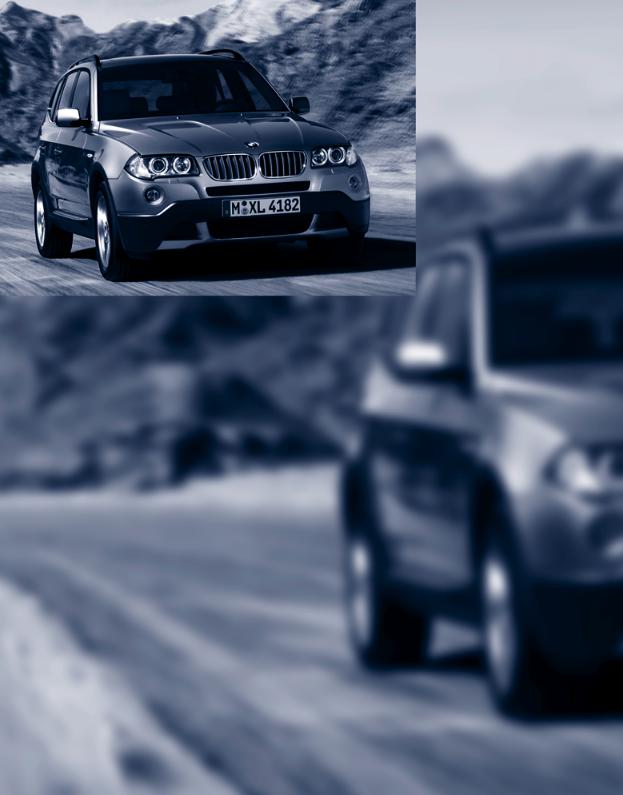
Online Edition for Part no. 01 41 2 602 348 - © 02/09 BMW AG
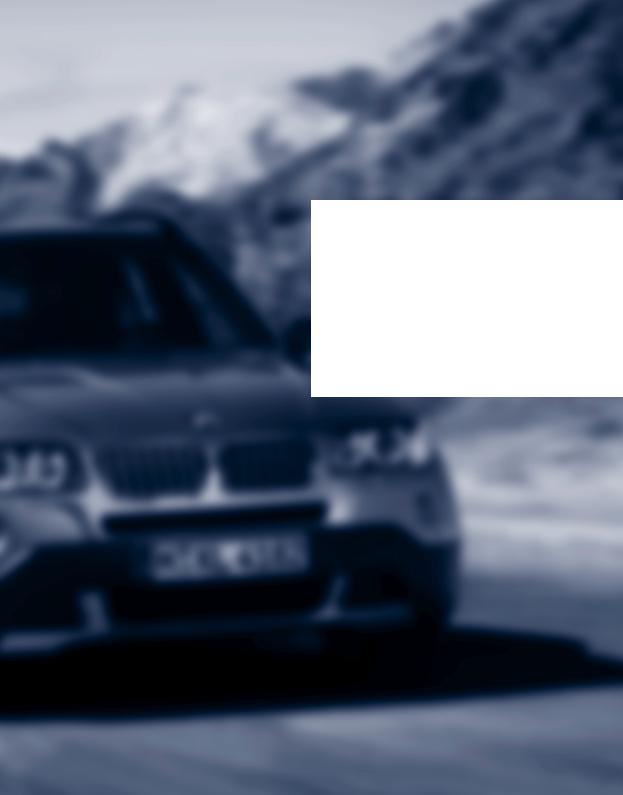
At a glance
This overview of buttons, switches and displays is intended to familiarize you with your vehicle's operating environment. The section will also assist you in becoming acquainted with the control concepts and options available for operating the various systems.
Online Edition for Part no. 01 41 2 602 348 - © 02/09 BMW AG
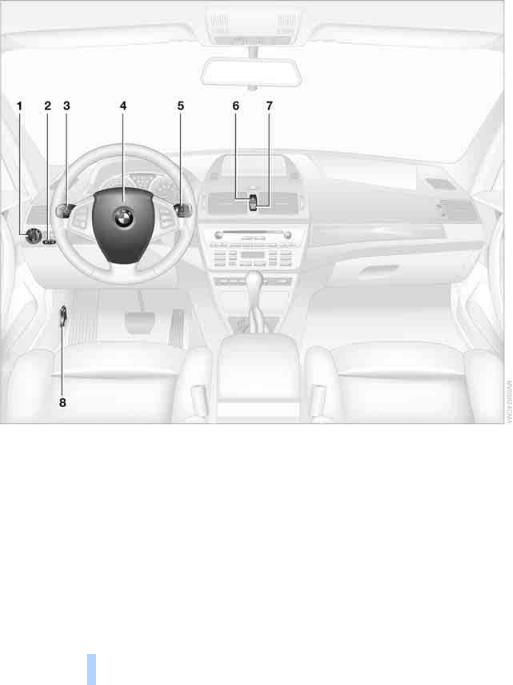
Cockpit
Cockpit
Controls
1 |
Parking lamps/low beams |
59 |
4 |
Horn, the entire surface |
|
2 |
Front fog lamps* |
61 |
|
5 |
Washer/wiper system/rain sensor* 42 |
3 |
> Turn signals |
41 |
|
6 |
Hazard warning flashers |
|
> Roadside parking lamps |
60 |
7 |
Central locking system 19 |
|
|
> High beams 60 |
|
8 |
Unlocking hood 101 |
|
>Headlamp flasher 41
>Computer 48
10
Online Edition for Part no. 01 41 2 602 348 - © 02/09 BMW AG
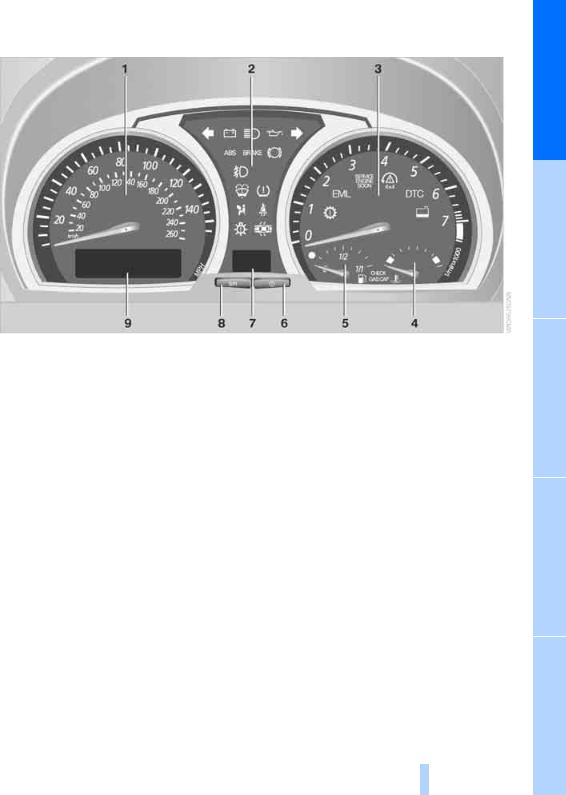
Instrument cluster
1Speedometer
2Indicator and warning lamps 12
3Tachometer 46
Indicator and warning lamps 12
4Coolant temperature gauge 47
5Fuel gauge 46
6Button for
>Displaying the time 47
>Service Interval Display 47
>Checking oil level 103
7Selector lever and program displays for automatic transmission* 40
8Button for
>Resetting trip odometer 46
>Setting time 47
9Display for
>Trip odometer/odometer 46
>Time 47
>Service Interval 47
>Computer 48
>Checking oil level 103
11
Online Edition for Part no. 01 41 2 602 348 - © 02/09 BMW AG
At a glance
Controls
Driving tips
Mobility
Reference
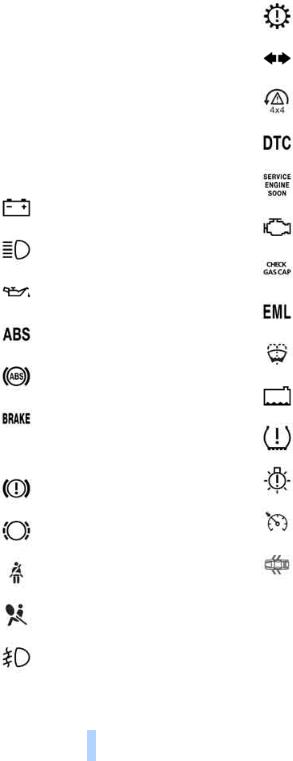
Cockpit
Indicator and warning lamps
Technology that monitors itself
Indicator and warning lamps that are identified with + are checked for proper function each time you turn the ignition key. They each light up once for different periods of time.
When a malfunction occurs in a monitored system, the corresponding lamp will either fail to go out when the engine is started, or it will come on again during normal driving. Detailed information is provided on the specified pages.
Battery charge current + 118
Headlamp flasher 41
High beams 60
Engine oil + 103
Driving stability control systems/
ABS Antilock Brake System + 51
ABS Antilock Brake System/chassis control system for Canadian models
Brake system +
With handbrake released 53, 105
With handbrake engaged 39
With other warning lamps 53
Brake warning lamp for Canadian models
Brake pads + 85
Please fasten safety belts + 32
Airbags + 57
Front fog lamps 61
Automatic transmission + 40
Turn signals 41
DSC Dynamic Stability Control/ xDrive + 51, 52
DTC Dynamic Traction Control + 52
Service Engine Soon + 107
Service Engine Soon warning lamp for Canadian models.
Check Gas Cap* + 92
Engine electronics + 38
Topping off washer fluid 43
Coolant low 105
Flat Tire Monitor* + 54
Tire Pressure Monitor* + 55
Lamp defective 59
Cruise control 44
Door or liftgate open
12
Online Edition for Part no. 01 41 2 602 348 - © 02/09 BMW AG
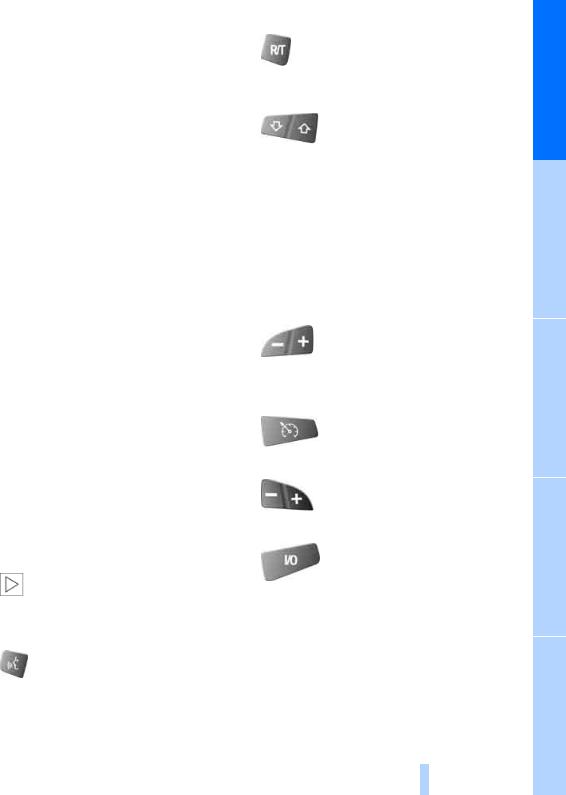
Colors
The indicator and warning lamps can light up in different colors and combinations.
The following section explains the significance of the individual colors as well as how you should respond when they appear.
>red:
Stop the vehicle immediately or
An important reminder
>yellow:
Have the system inspected as soon as possible
or
For your information
>green:
For your information
>blue:
For your information
Buttons* on steering wheel
The buttons integrated into the steering wheel are provided so that you can operate a number of accessories quickly and without being distracted from traffic conditions. You may operate:
>Selected audio source functions
>Recirculated-air mode/steering wheel heater
>Cruise control
>Selected telephone functions
>Voice activation system
In order to operate a system, it must be switched on.<
Display/hide phonebook. Display entries consecutively with buttons for fast forward/reverse
Fast forward/reverse
>Radio
Press the button: next stored station Extended pressure: station search function
>CD
Press the button: skip track
Extended pressure: fast forward/reverse
>Phone
Browse through list of names
Volume
Cruise control*
Resume
+ accelerate and store, – decelerate and store
Activate/interrupt/deactivate
Telephone*/voice activation system*/ audio sources*
>Press the button: answer and terminate call, begin dialing selected phone number
>Extended pressure: activate/deactivate voice command system
13
Online Edition for Part no. 01 41 2 602 348 - © 02/09 BMW AG
At a glance
Controls
Driving tips
Mobility
Reference

Cockpit
Recirculated-air mode/steering wheel heater*
Depending on the equipment package, a button is provided for the recirculated-air
mode or steering wheel heater.<
Switch recirculated-air mode on and off
Switch steering wheel heater on/off, refer to page 34
14
Online Edition for Part no. 01 41 2 602 348 - © 02/09 BMW AG

15
Online Edition for Part no. 01 41 2 602 348 - © 02/09 BMW AG
At a glance
Controls
Driving tips
Mobility
Reference
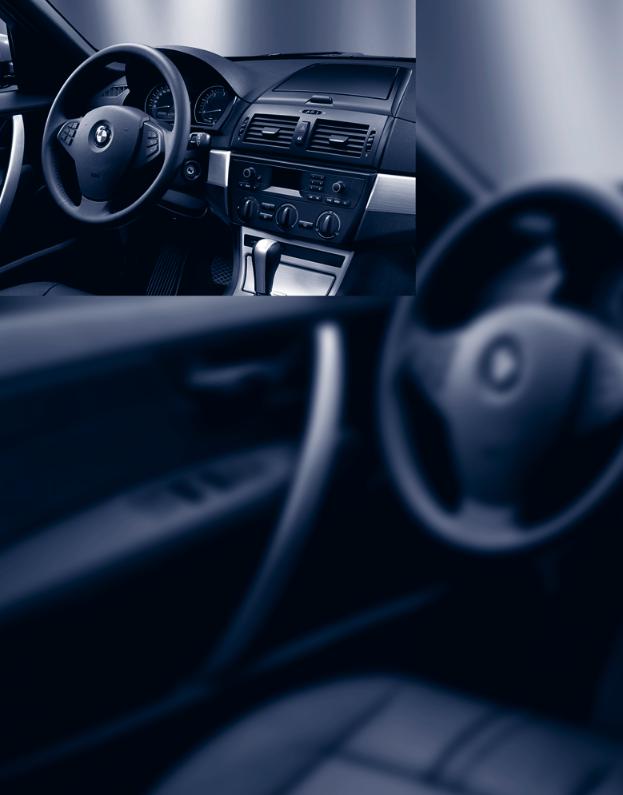
Online Edition for Part no. 01 41 2 602 348 - © 02/09 BMW AG
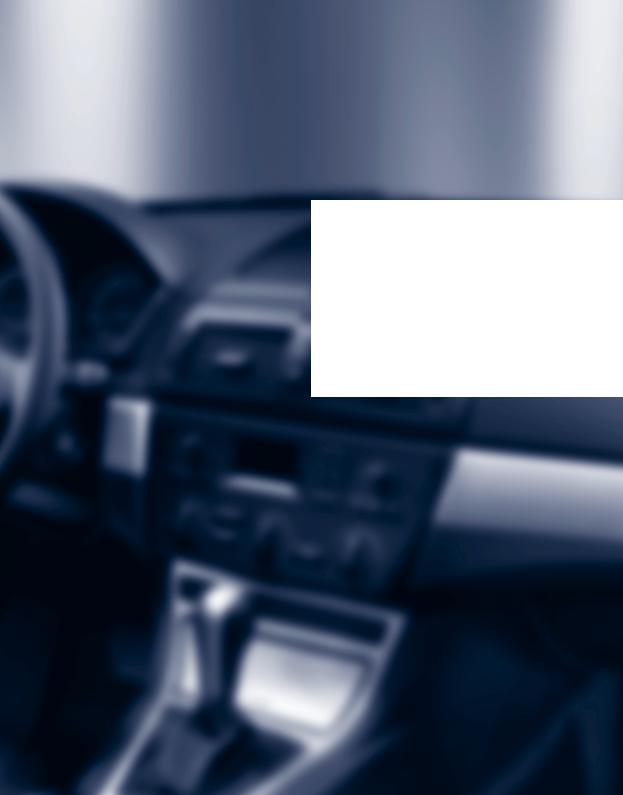
Controls
This chapter is intended to provide you with information for complete control of your vehicle and describes its extensive array of features and accessories, both for driving and for your own safety, comfort and convenience.
Online Edition for Part no. 01 41 2 602 348 - © 02/09 BMW AG
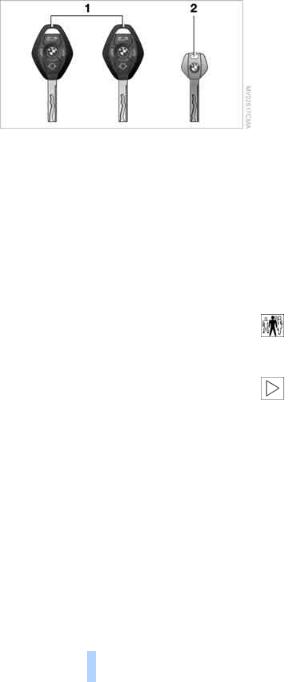
Opening and closing
Opening and closing
Key set
1Master keys with remote control
2Spare key
Master keys with remote control
Each master key contains a battery that is automatically charged in the ignition lock during driving. Use the master key at least twice a year in order to maintain its charge condition.
Depending on which master key is detected by the vehicle during unlocking, different settings in the vehicle are requested and executed, refer to Key Memory.
Spare key
For storage in a safe place, such as in your wallet.
This key does not fit in the lock of the glove compartment. This is an advantage, e.g. when valet parking. The key is not intended for constant use.
ments. In developing your vehicle, BMW has incorporated a number of options for personal adjustment. You can have these programmed at your BMW Sports Activity Vehicle Center.
There are vehicle-related and person-related adjustments: Vehicle Memory and Key Memory. You can configure up to four different basic adjustments for four different persons. The only requirement is that each person use his or her own master key with remote control.
When your vehicle is unlocked with the remote control, the vehicle recognizes the individual user by means of a data exchange with the key, and makes adjustments accordingly.
In order for you to distinguish between the master keys with remote control, color-coded decals are supplied together with the keys.
What the system can do
Ask your BMW Sports Activity Vehicle Center about the possibilities of Vehicle Memory and Key Memory.
You will see this symbol throughout the Owner's Manual. It is to remind you at
appropriate places of the settings that are available to you.<
Following configuration of memory functions, vehicle operation may differ from
the description in the Owner's Manual. Should you wish to sell your BMW some day, please remember to have the memory functions reset to the factory default settings.<
New keys
You can get replacement keys or spare keys |
Examples of Vehicle Memory |
|
from your BMW Sports Activity Vehicle Center. |
> Different confirmation signals to confirm |
|
|
locking/unlocking of the vehicle, refer to |
|
Vehicle Memory, Key Memory |
page 19. |
|
> Activating/deactivating function for path- |
||
How the system functions |
way lighting, refer to page 59. |
|
> Activating/deactivating daytime driving |
||
You have probably frequently wished that you |
||
lamps, refer to page 59. |
||
could configure individual functions of your |
|
|
vehicle to reflect your own personal require- |
|
18
Online Edition for Part no. 01 41 2 602 348 - © 02/09 BMW AG

>Active PDC Park Distance Control is acoustically indicated by a signal tone when you shift into reverse or move the selector lever into position R, refer to page 50.
>Different confirmation signals to confirm arming/disarming of alarm system, refer to page 25.
>After an outside temperature warning has been issued, the computer display returns to the previous setting, refer to page 48.
>Acoustic warning if the ignition key remains in the ignition lock after the driver's door has been opened, refer to page 19.
Examples of Key Memory functions
>Locking the vehicle after starting to drive, refer to page 21.
>Automatic adjustment of the driver's seat and exterior mirror position for each person when unlocking the vehicle, refer to
page 31.
>Setting units of measure for instrument cluster displays of time, outside temperature, distance driven, and fuel consumption, refer to page 48.
For additional details on the alarm system, refer to page 25.
You can set an acoustic signal to remind you if the ignition key is still in the ignition
lock after you open the driver's door.<
Operating from inside
Via the central locking system button, refer to page 21.
When the system is locked from inside, the fuel filler door remains unlocked.
In the event of an accident of sufficient severity, the central locking system unlocks automatically. In addition, the hazard warning flashers and interior lamps switch on.
Opening and closing: Using the remote control
Persons or animals left unattended in a parked vehicle can lock the doors from the inside. For this reason, bring the remote
control with you whenever you leave the vehicle so that you will always be able to unlock the vehicle from outside.<
Central locking system
The concept
The central locking system is ready for operation whenever the driver's door is closed.
The system locks or unlocks: > doors
Unlocking
1.Press the  button.
button.
The driver's door and fuel filler door are unlocked.
2.Press the  button again.
button again.
All remaining doors and the liftgate are unlocked.
>liftgate
>fuel filler door
Operating from outside
>via the remote control
>via the driver's door lock
Convenience opening mode
Press and hold the  button.
button.
The windows and panorama glass sunroof* are opened, the exterior mirrors are folded open*.
If you wish, you can have this special feature activated/deactivated.<
The interior lamps and courtesy lamps* are switched on and off with the remote control. The alarm system* is also armed or disarmed.
Engaging locks
Press the  button.
button.
Hazard warning flashers flash once.
19 
Online Edition for Part no. 01 41 2 602 348 - © 02/09 BMW AG
At a glance
Controls
Driving tips
Mobility
Reference

Opening and closing
If you wish, you can have this special feature deactivated on vehicles without an
alarm system.<
Do not lock the vehicle from the outside when people are in it since they will be
unable to unlock it from the inside if they do not know the special procedure.<
If you unlock the vehicle, but do not open any doors, the central locking system
automatically relocks the vehicle after a short time. If you wish, you can have this special feature activated/deactivated.<
Switching off tilt alarm sensor* and interior motion sensor*
Press the  button again directly after locking.
button again directly after locking.
For details, refer to page 26.
Switching on interior lamps
With the vehicle locked: Press the  button.
button.
You can also use this function to locate your vehicle in parking garages etc.
Panic mode*
You can also trigger the alarm system* in case of danger:
Press the  button for at least 3 seconds.
button for at least 3 seconds.
Deactivating alarm
>When vehicle is unlocked
Press button for unlocking or locking
>When vehicle is locked Press button for unlocking
Unlocking liftgate
Press the  button.
button.
The liftgate will open slightly, regardless of whether it was previously locked or unlocked.
If you wish, you can have the liftgate open only after the vehicle has been unlocked.
You may have this function activated/deactivated.<
To avoid damage, make sure there is sufficient space when opening the liftgate.
A previously locked liftgate is also locked again after closing.
Before and after a drive, make sure that the liftgate has not been inadvertently released.<
Malfunction
The remote control may malfunction due to local radio waves.
Should this occur, use the master key to unlock and relock the vehicle via the door lock.
If it is no longer possible to lock the vehicle using the remote control, its battery is discharged. Use this remote control during an extended drive; this will recharge the battery, refer to page 18.
For US owners only
The transmitter and receiver units comply with part 15 of the FCC/Federal Communications Commission regulations. Operation is governed by the following:
FCC ID:
LX8EWS
LX8FZVS
LX8FZVE
Compliance statement:
This device complies with part 15 of the FCC Rules. Operation is subject to the following two conditions:
>This device must not cause harmful interference, and
>this device must accept any interference received, including interference that may cause undesired operation.
Any unauthorized modifications or changes to these devices could void the
user's authority to operate this equipment.<
20
Online Edition for Part no. 01 41 2 602 348 - © 02/09 BMW AG
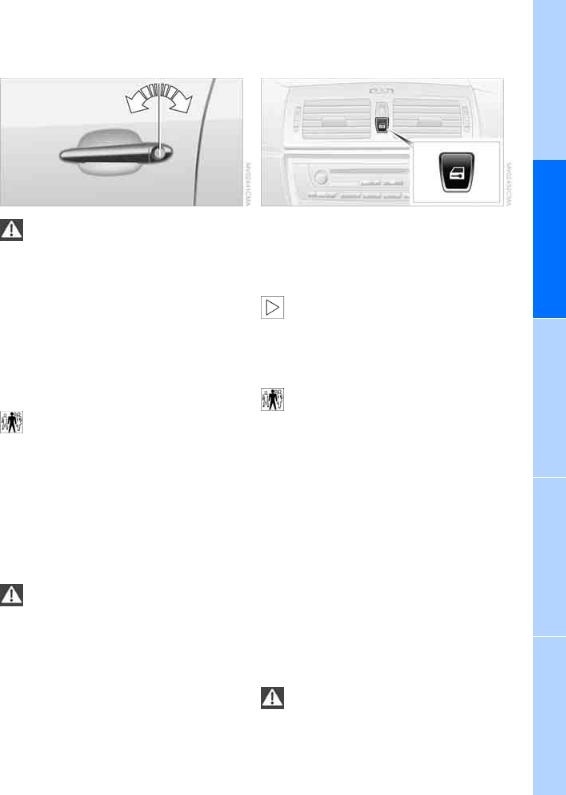
Opening and closing: |
Opening and closing: |
Using door lock |
From inside |
At a glance
Do not lock the vehicle from the outside when people are in it since they will be
unable to unlock it from the inside if they do not know the special procedure.<
1.Turn key.
The driver's door and fuel filler door are unlocked.
2.Turn key again.
All remaining doors and the liftgate are unlocked.
When locking, the hazard warning flashers flash once.
If you wish, you can have this special feature deactivated on vehicles without an
alarm system.<
You can use this button to operate the central locking system when the front doors are closed. This button only unlocks or locks the doors and the liftgate. It does not activate the anti-theft system.
If only the driver's door was unlocked from the outside and you press the but-
ton, then, with the driver's door still open, the passenger side door, the liftgate and the fuel filler door will unlock, too.
If the driver's door is closed, it will be locked.<
The central locking system locks automatically after you begin to drive. You can
have your vehicle set to do this if you wish.<
Unlocking and opening doors
Convenience operation |
> Either unlock all of the doors via the central |
|
You can also use the door lock to open and |
locking system button and then pull on the |
|
door handle above the armrest or |
||
close the windows and the panorama glass |
||
> pull the door handle of each door twice: the |
||
sunroof* and to fold the exterior mirrors in and |
||
out*. |
first time unlocks the door, the second time |
|
Hold the key in the unlocking or locking posi- |
opens it. |
|
|
||
tion. |
Engaging locks |
|
Watch during the closing process to be |
||
> Either lock all doors via the central locking |
||
sure that no one is injured. Releasing the |
||
key stops the operation.< |
system button or |
|
> press down the lock buttons of the doors. |
||
|
||
Manual operation |
To prevent you from being locked out, the |
|
|
opened driver's door cannot be locked |
If an electrical malfunction occurs, you can |
using the lock button. |
|||
unlock or lock the driver's door with the key in |
||||
Persons or animals left unattended in a |
||||
the end positions of the door lock. |
||||
parked vehicle can lock the doors from |
||||
|
||||
|
the inside. For this reason, bring the ignition key |
|||
|
with you whenever you leave the vehicle so that |
|||
|
21 |
|
|
|
|
|
|
||
Online Edition for Part no. 01 41 2 602 348 - © 02/09 BMW AG |
|
|
||
|
|
|
|
|
Controls
Driving tips
Mobility
Reference
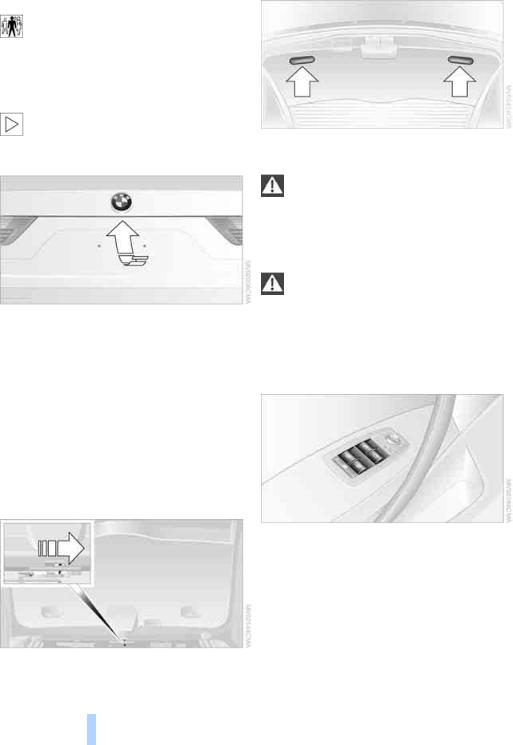
Opening and closing
you will always be able to unlock the vehicle |
Closing |
from outside.< |
|
You can set an acoustic signal to remind |
|
you if the ignition key is still in the ignition |
|
lock after you open the driver's door.< |
|
Liftgate
To avoid damage, make sure there is suf- |
|
ficient space when opening the liftgate.< |
|
|
The handle recesses on the interior trim of the |
Opening from outside |
liftgate make it easier to pull down. |
|
Avoid injuries by making sure that the lift- |
|
gate's closing region is clear and unob- |
|
structed.< |
Press the button, refer to arrow, or the  button on the remote control. The liftgate opens slightly. It can be pivoted upward.
button on the remote control. The liftgate opens slightly. It can be pivoted upward.
When the liftgate is open, the cargo area and interior are illuminated.
Opening manually
In the event of an electrical malfunction:
1.Lift up the floor cover in the cargo area.
2.Release the jack from the bracket.
3.Press the lever behind the cover to the side, refer to arrow. The liftgate is released.
The liftgate is locked again as soon as it is closed.
Windows
Keep windows in your line of sight while closing. Failure to do so can result in
bodily injury.
Always remove the key when leaving the vehicle; otherwise, children could operate the windows and injure themselves.<
Opening, closing
With the ignition key in position 1 or higher:
>Press the switch to the resistance point: The window continues to open as long as you press the switch.
>Press the switch past the resistance point: The window opens automatically. Pressing again stops the opening motion.
You can close the windows in the same manner by pulling the switch.
22
Online Edition for Part no. 01 41 2 602 348 - © 02/09 BMW AG
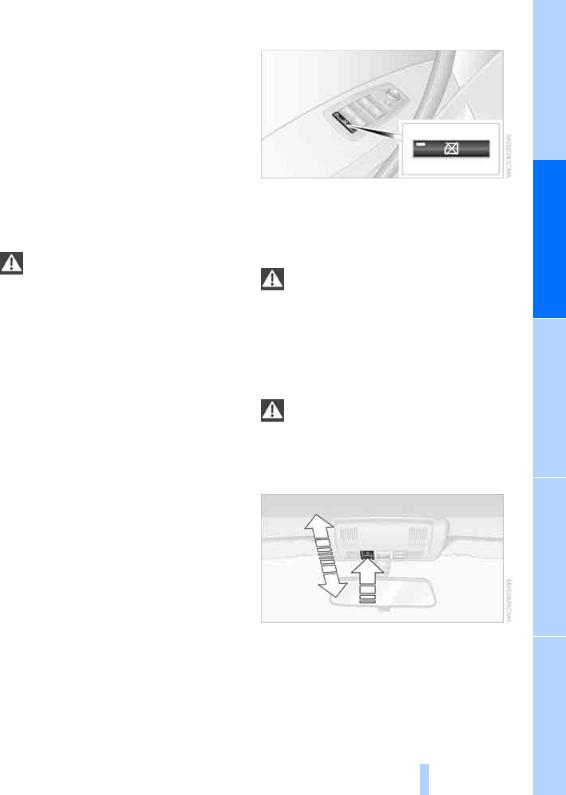
In the back, separate switches are provided in the armrests.
For convenience operation using the remote control or the door lock, refer to pages 19, 21.
After switching off ignition
You can operate the windows for up to 1 minute as long as no door has been opened.
Pinch protection system
If the closing force rises beyond a predefined threshold when a window is being closed, the system will interrupt the closing of the window prior to lowering it slightly.
Despite the presence of the pinch protection system, inspect the window's travel
path prior to closing it, as the safety system might fail to detect certain kinds of obstructions, such as very thin objects, and the window would continue closing.
Do not install any accessories in the movement range of the window as this could impair the function of the pinch protection system.<
Closing without pinch protection system
When there is danger outside or when, for example, ice on the window prevents a normal closing, press the switch past the resistance point and hold it there. The window will close without the pinch protection system.
Following interruptions in electrical power supply
After disconnecting the battery, the pinch protection system must be reinitialized. To do this, open and close the windows once and continue pull the switch for longer than approx. 2 seconds after closing.
Safety switch
With the safety switch, you can prevent the rear windows from being opened or closed via the switches in the rear passenger area, by children, for example. The LED lights up when this safety function is activated.
Press the safety switch when children ride in the rear; otherwise, unsupervised
closing of the windows could lead to injuries.<
Panorama glass sunroof*
The panorama glass sunroof is ready for operation with the ignition key in position 2.
Keep panorama glass sunroof in your line of sight while closing. Failure to do so can
result in bodily injury.
Always remove the key when leaving the vehicle; otherwise, children could operate the sunroof and injure themselves.<
Raising
Press the switch.
The closed roof is raised and the sliding visor opens slightly.
23
Online Edition for Part no. 01 41 2 602 348 - © 02/09 BMW AG
At a glance
Controls
Driving tips
Mobility
Reference

Opening and closing
Do not use force to close the sliding visor when the sunroof is in its raised position,
as this could damage the mechanism.<
Opening, closing
Sliding visor
You can move the sliding visor independently when the roof is in the closed or raised position.
>Slide the switch backward to the resistance point.
The sliding visor continues to open for as long as you hold the switch in this position.
>Press the switch backward briefly past the resistance point.
The sliding visor opens automatically. Press the switch briefly to stop the movement.
You close the sliding visor in the same way by sliding the switch forward.
Panorama glass sunroof
With the sliding visor open, proceed as described under Sliding visor.
For convenience operation using the remote control or the door lock, refer to page 19 or 21.
Opening and closing sunroof and sliding visor together
Briefly press the switch past the resistance point twice consecutively.
Press the switch briefly to stop the movement.
Convenience functions
>With the sunroof open, press the switch twice:
The sunroof is raised.
>With the sunroof raised, briefly press the switch twice in the opening direction: The sunroof is completely opened.
Comfort position
In the comfort position, the sunroof is not completely open. This reduces the wind noise in the passenger compartment.
Each time the panorama glass sunroof is completely opened or closed, it stops in the comfort position. If you wish, you can resume the motion by activating the switch.
After switching off ignition
You can operate the panorama glass sunroof for approx. 1 minute as long as no door has been opened.
Pinch protection system
If the panorama glass sunroof or sliding visor encounter resistance when closing from roughly one third of the roof opening or when closing from the raised position, then the closing action is interrupted and the panorama glass sunroof and sliding visor reopen slightly.
Despite the presence of the pinch protection system, inspect the sunroof's travel
path prior to closing it, as the safety system might fail to detect certain kinds of obstructions, such as very thin objects, and the sunroof would continue closing.<
Closing without pinch protection system
If there is danger outside, press the switch beyond the resistance point and hold it there. The sunroof will close without the pinch protection system.
Following interruptions in electrical power supply
After a power supply interruption, it may only be possible to raise the sunroof. Have the system initialized. BMW recommends having this work carried out by your BMW Sports Activity Vehicle Center.
24
Online Edition for Part no. 01 41 2 602 348 - © 02/09 BMW AG
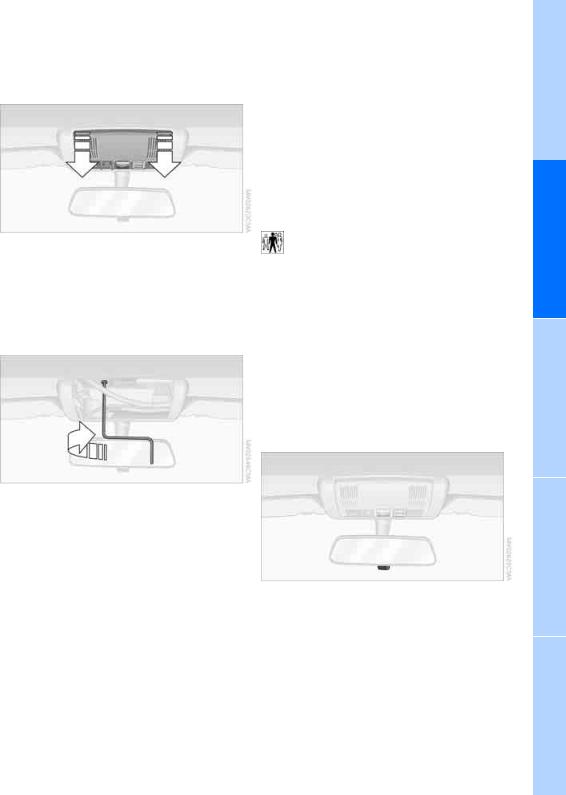
Moving manually*
In the event of an electrical malfunction, you can move the sunroof manually.
1. Pull the cover firmly downward to remove.
2.Take the Allen wrench* from the compartment under cargo area floor, refer to
page 116, and insert it into the opening provided. Move the sunroof into the desired position. The arrow in the illustration indicates the rotation direction for closing the sunroof.
The alarm system signals unauthorized manipulations for a short time by:
>Sounding an acoustic alarm
>Switching on the hazard warning flashers
>Flashing the high beams
Arming and disarming alarm system
When you lock or unlock the vehicle, either with the remote control or at the door lock, the alarm system is armed or disarmed at the same time.
If the alarm system has been properly armed, the hazard warning flashers light up once.
You can have different confirmation signals set to confirm arming and disarm-
ing.<
You can open the liftgate even when the system is armed by using the  button of the remote control, refer to page 20. When the liftgate is closed, it is locked again and monitored.
button of the remote control, refer to page 20. When the liftgate is closed, it is locked again and monitored.
Switching off alarm
>Unlock the vehicle using the remote control, refer to page 19.
>Turn the ignition key to position 1.
Indicator lamp displays
Alarm system*
The concept
The vehicle alarm system responds:
>When a door, the hood, or the liftgate is opened.
>To movements inside the vehicle: interior motion sensor, refer to description below.
>When the car's inclination changes, for instance if an attempt is made to jack it up and steal the wheels or to raise it prior to towing away.
>To interruptions in battery voltage.
>The indicator lamp below the interior rearview mirror flashes continuously: the system is armed.
>The indicator lamp flashes after the vehicle is locked: doors, hood, or liftgate are not properly closed. Even if you do not close the alerted area, the system begins to monitor the remaining areas, and the indicator lamp flashes continuously after approx. 10 sec-
25 
Online Edition for Part no. 01 41 2 602 348 - © 02/09 BMW AG
At a glance
Controls
Driving tips
Mobility
Reference

Opening and closing
onds. However, the interior motion sensor is not activated.
>The indicator lamp goes out after unlocking: no manipulation or attempted intrusions have been detected in the period since the system was armed.
>The indicator lamp flashes for 10 seconds after the vehicle is unlocked: an attempted entry has been detected in the period since the system was armed.
Following triggering of an alarm, the indicator lamp will flash continuously.
Tilt alarm sensor
The tilt of the vehicle is monitored. The alarm system reacts, e.g. in case of an attempted wheel theft or towing.
Interior motion sensor
In order for the interior motion sensor to function properly, the windows and panorama glass sunroof must be completely closed.
Avoiding unintentional alarms
The tilt alarm sensor and interior motion sensor may be switched off at the same time. This prevents unintentional alarms, e.g. in the following situations:
>In duplex garages
>When being transported on car-carrying trains, aboard ship, or on a trailer
>When animals are to remain in the vehicle
Switching off tilt alarm sensor and interior motion sensor
Press the  button on the remote control again as soon as the vehicle is locked.
button on the remote control again as soon as the vehicle is locked.
The indicator lamp lights up briefly and then flashes continuously. The tilt alarm sensor and the interior motion sensor are switched off until the next time the vehicle is unlocked and subsequently locked again.
If you wish, you can have the tilt alarm sensor and interior motion sensor perma-
nently deactivated. You can have this setting made at your BMW Sports Activity Vehicle Center.<
26
Online Edition for Part no. 01 41 2 602 348 - © 02/09 BMW AG

Adjustments
Sitting safely
The ideal sitting position can make a vital contribution to relaxed driving that is as fatigue-free as possible. Together with safety belts, head restraints, and airbags, sitting position plays an important role in an accident. Compliance with the following instructions is important; failure to do so could impair the protective function of the safety systems.
For additional information on transporting children safely, refer to page 35.
Airbags
Always maintain an adequate distance between yourself and the airbags. Always
hold the steering wheel by its rim with hands at the 9 o'clock and 3 o'clock positions, to minimize the risk of injuries to your hands and arms in the event of airbag deployment.
No one and nothing is to come between the airbags and the seat occupant.
Do not use the cover of the front airbag on the front passenger side as a storage area. Make sure that the passenger sits correctly, e.g. does not rest his feet or legs on the instrument cluster. Otherwise, a triggering of the front airbag could result in leg injuries. Make sure that passengers do not lean their heads against side or head airbags. Otherwise, a triggering of the airbag could result in injuries.<
Even if you adhere to all the instructions, injuries resulting from contact with airbags cannot be entirely ruled out, depending on the circumstances. The ignition and inflation noise may provoke a mild – usually temporary – hearing loss in extremely sensitive individuals.
For airbag locations and additional information on airbags, refer to page 57.
Head restraint
A correctly adjusted head restraint reduces the risk of damage to the cervical vertebrae in accidents.
Adjust the head restraint so that its middle lies approximately at the height of
your ears. Otherwise, there is an increased risk of injury in the event of an accident.<
Head restraints, refer to page 29.
Safety belts
Make sure the safety belts are worn in all occupied seats every time you drive. Although airbags enhance safety by providing added protection, they are not a substitute for safety belts.
Your vehicle has five seats that are each equipped with a safety belt.
Never allow more than one person to wear a single safety belt. Infants and chil-
dren must not ride on a lap. Make sure that the belt in the lap area sits low against the hips and does not press against the abdomen. The safety belt must never rest against the throat, rub against sharp edges, pass over hard or fragile objects or be pinched. Fasten the safety belt around your body snugly, making sure that it is pulled taut across your lap and shoulder and that it is not twisted; otherwise, the belt can slide over the hips in the event of a frontal collision and injure your abdomen. Avoid wearing clothing that prevents the belt from fitting properly and pull the shoulder belt upward periodically to readjust the tension across your lap in order to avoid a reduction in the restraining action of the safety belt.
If the middle safety belt is used, the larger part of the backrest must be locked in position, refer to page 76; otherwise, the middle safety belt cannot exert any restraining action.<
Safety belts, refer to page 32.
27
Online Edition for Part no. 01 41 2 602 348 - © 02/09 BMW AG
At a glance
Controls
Driving tips
Mobility
Reference
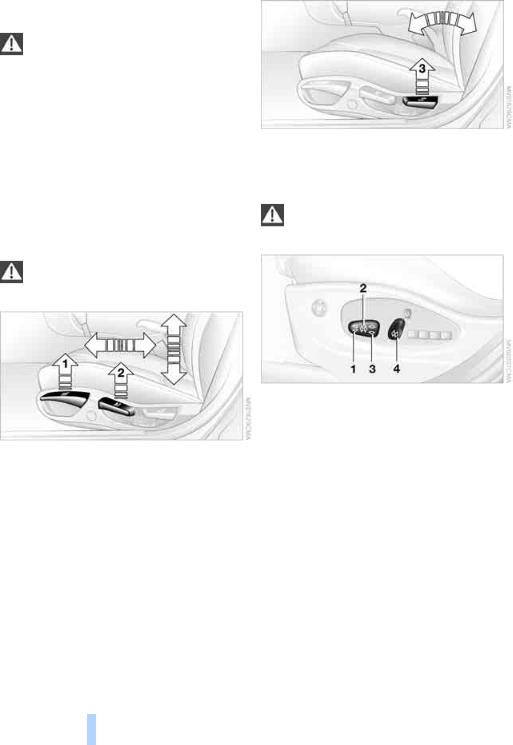
Adjustments
Seats
Note before adjusting
Never try to adjust your seat while operating the vehicle. The seat could respond
with unexpected movement, and the ensuing loss of vehicle control could lead to an accident. On the passenger seat as well, do not incline the backrest too far to the rear while the vehicle is being driven; otherwise, there is a danger in the event of an accident of sliding under the safety belt, eliminating the protection normally provided by the belt.<
Also follow the instructions regarding the height of head restraints on page 29 and regarding safety belt damage on page 33.
Adjusting manually
To ensure that the safety systems continue to provide optimized protection,
follow the adjustment instructions above.<
Backrest
Pull the lever 3 and apply weight to or remove weight from the backrest as needed.
Adjusting electrically*
To ensure that the safety systems continue to provide optimized protection, fol-
low the adjustment instructions above.<
Longitudinal direction
Pull the lever 1 and slide the seat into the desired position.
After you release the lever, move the seat forward or backward slightly so that it engages fully.
Height
Pull the lever 2 and apply weight to or remove weight from the seat as needed.
1Tilt
2Longitudinal direction
3Height
4Backrest
Manually adjusting head restraint, refer to Head restraints on page 29.
Luxury seat*
With this seat, you can also electrically adjust the height of the head restraint and the shoulder support.
28
Online Edition for Part no. 01 41 2 602 348 - © 02/09 BMW AG
